By Philip Cauchi
Introduction: This session is designed around securing possession of the ball until the moment to play forward is on. Our focus in this session is to develop the individual within team training. Therefore, we focus mainly on developing game insight, and decision-making both with and without the ball. Decision-making without the ball involves the creation of space through movement and timing to attack the space created. Decision-making with the ball includes whether to pass, dribble or shield the ball, to whom to pass and to which foot or space.
Category: Under 10 to under 12.
Level: Medium.
Team function: Team in possession.
Team task: Build-up.
Theme: Positional play.
Total duration: 90 minutes.
Number of players: 10 outfield players + 2 goalkeepers.
Main aim: Secure possession of the ball with the intention of creating opportunities to play forward.
Equipment needed: Markers to mark the practice areas (5 sets of 10, each set bearing a different color), agility ladder (x2), cones (x10), poles (x4 – 2 red and 2 yellow), bibs (a set of twelve bearing the same colour and another four of a different color), mini goals (x4 – if not available, cones may be used), and balls (at least 8 to allow for a smooth flow of the session).
Outcomes:
1. Positioning.
2. Spatial awareness.
3. Off-the-ball movement to offer support.
4. Stance.
5. Oriented first touch.
6. Quality of passes.
Activation 1: Passing by numbers.
Targeted outcomes: 2, 4, 5 and 6.
Duration: 5 minutes.
Players: Divided into two groups of six players each group. Players are numbered from 1 to 6.
Area: 12 yards by 8 yards with a pole positioned one meter outside the centre of each side.
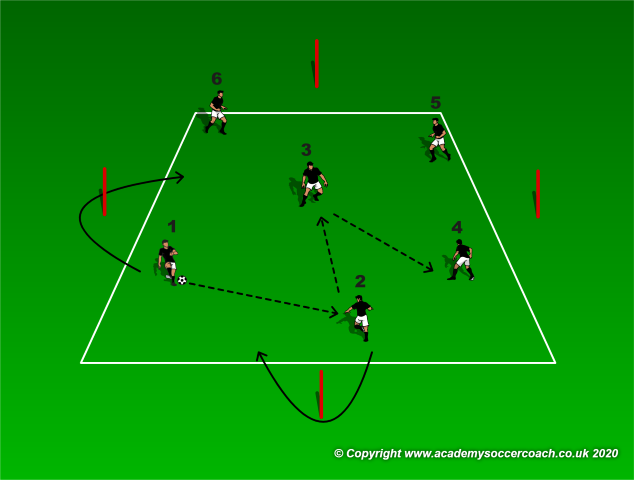
Description: The ball is passed between players in sequential order. The last player number 6 passes to player 1 to restart the sequence. After passing the ball, the players must go around a pole.
Variations:
1. Pass with a mandatory one touch.
2. Pass with a mandatory two touch so to work on the first touch.
Progression: Play with two balls simultaneously.
Activation 2: Passing by numbers rondo.
Targeted outcomes: 2, 4, 5 and 6.
Duration: 5 minutes.
Players: Five players are all given a number from 1 to 5. Another player acts as a defender.
Area: The same organization from activation 1 is kept.
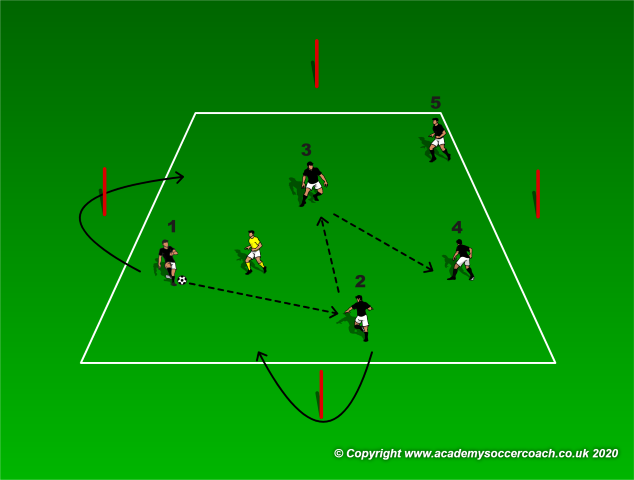
Description: The five attacking players pass the ball in sequential order without the defender intercepting the passes. After passing, the attackers must go around a pole.
Progression: To increase the physical intensity of the exercise, after passing the ball the players must go around the pole opposite them. Therefore the one which is the farthest.
SAQ training: Footwork then react and sprint.
Targeted outcomes: N/A.
Duration: 10 minutes.
Load: 2 sets x 6 repetitions with a 30 to 40 second rest in between repetitions and 3 minutes between sets.
Players: Two groups of players. The players coming from one of the sides are called leaders and the group opposite to them are called followers.
Area: Two agility ladders are positioned in front of each other and five yards apart. Two poles forming a gate are positioned 10 yards to the side of the ladders while another gate is formed in the opposite side at the same distance.
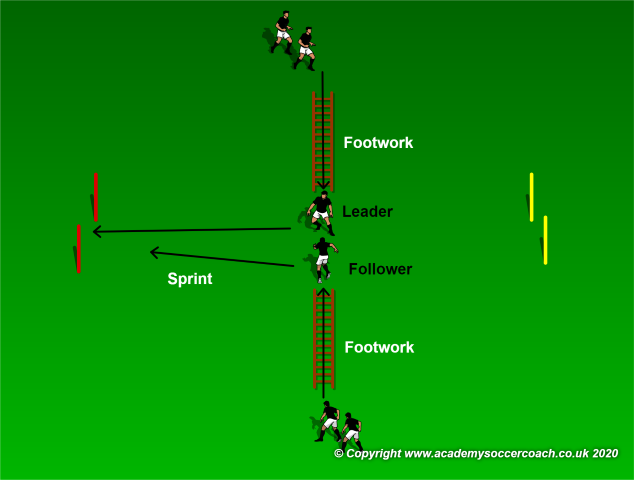
Description: One player from each group performs a pre-set quick footwork exercise using the agility ladder. Once in the middle, the leader decides to sprint to either the gate towards his right or the one towards his left. The follower tries to tag the leader before reaching the gate. The two players switch sides after each repetition.
Progressions:
1. The coach stands in the middle and raises either a red or yellow marker. The leader has to sprint to the gate indicated by the coach while the follower aims to tag him before passing through the gate.
2. The same as in progression 1 but the leader must sprint to the opposite gate as indicated by the coach.
Game 1: 3v3 on four goals.
Targeted outcomes: 1, 2, 3, 4, 5 and 6.
Duration: 15 minutes.
Load: 5 x 2 minutes with a minute rest in between series.
Players: Two setups where each setup is composed of two groups of three players each.
Area: 25 yards by 20 yards. A mini goal and a gate measuring 4 yards in width are set on each goal line.
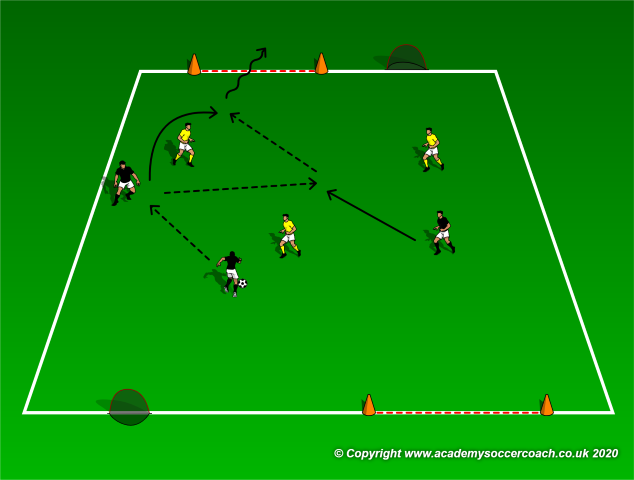
Description: Play is 3v3 with both teams attacking a gate and a mini goal positioned on the same goal line while defending the opposite. Scoring through the gate is achieved by dribbling, while scoring in the mini goal is achieved by passing the ball into the goal. The goalkeepers play as outfield players in this exercise.
Practice 1: 4v2 play to the target player.
Targeted outcomes: 1, 2, 3, 4, 5 and 6.
Duration: 12 minutes.
Load: 8 x 1 minute with 30 seconds of rest in between series.
Players: Four attackers and two defenders. Two of the four attackers are to be positioned at each end of the practice area.
Area: 15 yards by 12 yards. The final 3 yards from each end of the practice area should be assigned to the target player’s zone.
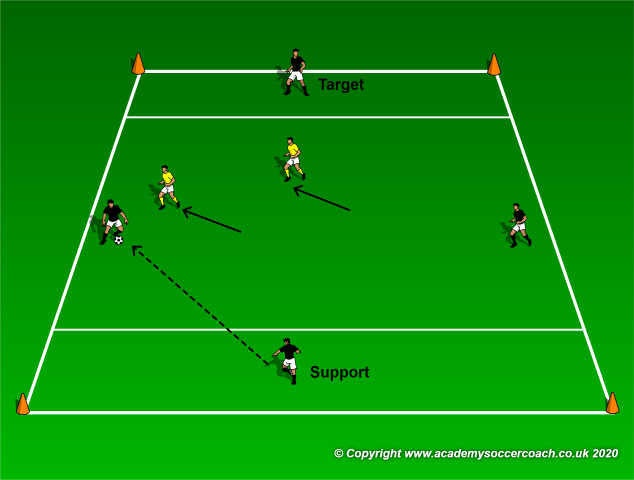
Description: The attackers aim to reach one of the target players with a pass. If they achieve this, the target player now becomes a support player who helps the team in possession in order to play the ball to the opposite target player (as shown in the previous diagram). Players switch roles after each repetition.
Variation: The target players may change places with the players from inside the area. This helps to develop the principle of mobility.
Progression: Keep the same variation as described above. However, now the player inside the support zone cannot play directly to the target player. Therefore, the ball must be played through the two inside players.
Practice 2: 4v2 play to the target player.
Targeted outcomes: 1, 2, 3, 4, 5 and 6.
Duration: 12 minutes.
Load: 4 x 2 minutes with 30 seconds of rest in between series.
Players: Four attackers and two defenders are positioned as shown in the below diagram.
Area: 15 yards by 12 yards. The target zones used in the previous practice are kept while two mini goals are positioned at one end of the practice area.
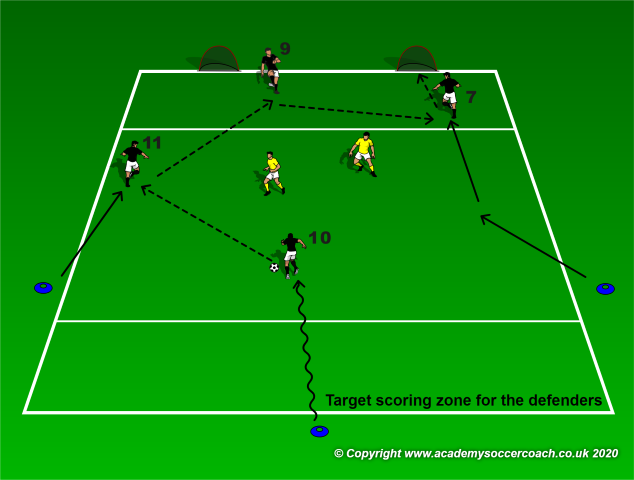
Description: The attacking team aims to combine with the target player prior to scoring (as shown in the above diagram). The attacking players move one position to their right so to experience attacking from different perspectives. The players change roles between series so that everyone experiences both defending and attacking. Should the defenders win the ball, they counter by stopping the ball in the opposite marked area.
Variations: If the attackers score without involving the target player it equals to one point. If the target player is involved in the goal it equals to two points.
Game 2: GK+5vGK+5.
Targeted outcomes: 1, 2, 3, 4, 5 and 6.
Duration: 23 minutes.
Load: 6 x 3 minutes with 1 minute of rest in between series.
Players: Each team is made up of a goalkeeper in goal and five outfield players.
Area: 40 yards by 30 yards.
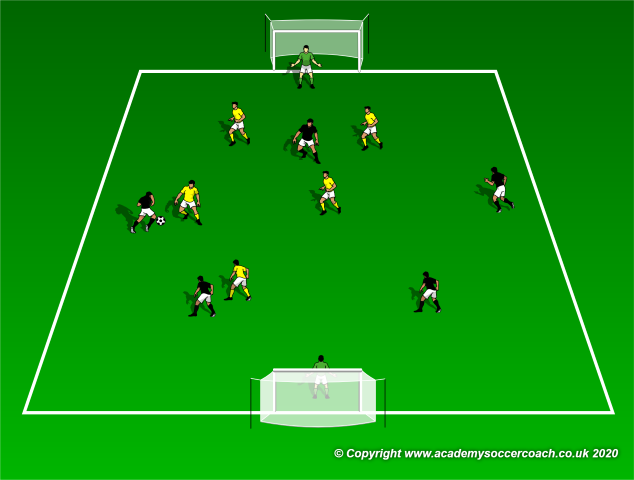
Description: This is a normal game but as we are working on build-up we want this to occur frequently. Therefore no throw-ins or corner kicks are in effect. The goalkeeper of the team in possession restarts play from the team’s own defending third.
Cool down: Have the players passing in groups of three while moving in space and keeping a triangular shape. There should be not any pre-set sequence of passing, let the players come up with different combinations. End the session with a few static stretches. The total duration of the warm-up should take approximately 8 minutes.
By Philip Cauchi


